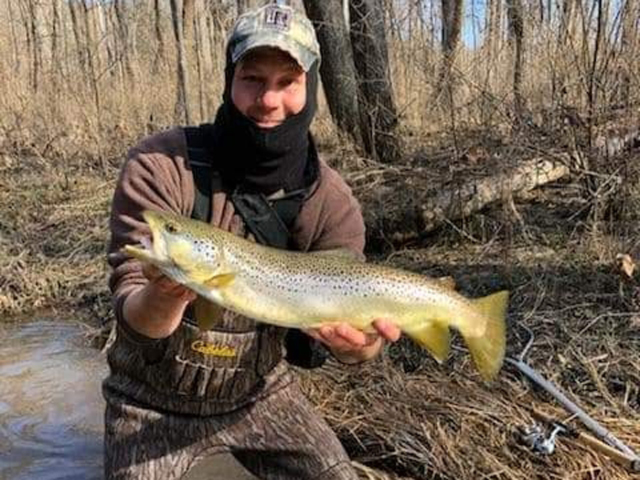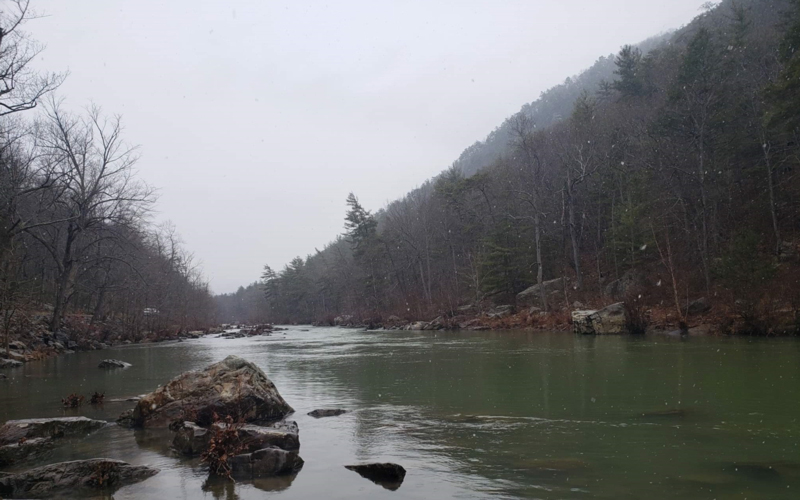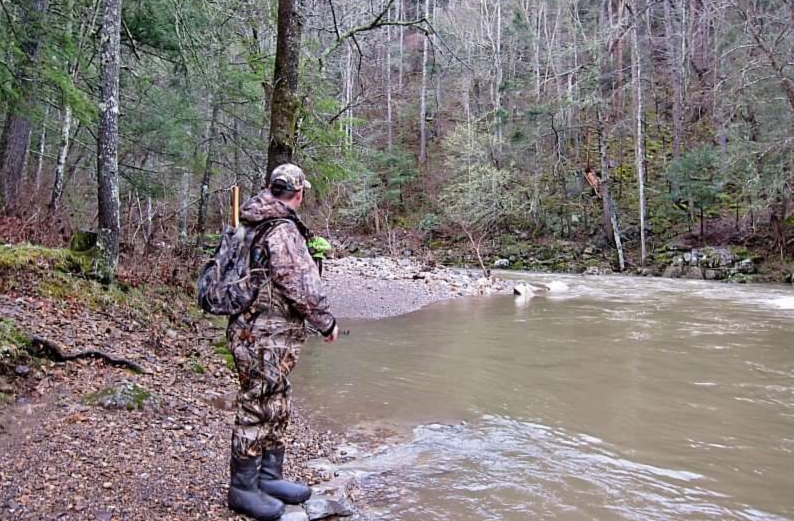While the inshore waters of the Chesapeake Bay are in their wintery slumber, the trout fishing in the highlands is on fire. This lull between deer season and the spring saltwater bite is the ideal time to head to the mountains and wade through some of our region’s finest scenery. Bugs and nymphs are almost nonexistent this time of year causing these stealthy hunters to key in on smaller forage fish and readily eat a variety of lures in the process. While trout normally range in the two- to four-pound weight class, they pack a whole lot of fight — especially when they turn downstream for a screaming run.

Three primary species of freshwater trout inhabit Virginia's water consisting of the Brown, Rainbow, and Brook varieties. A mixture of these gets stocked in streams, rivers, and lakes throughout the state using funds collected from licenses and trout stamps. For this reason alone, you should always do your part and purchase a trout license. Not only are you directly funding this impressive fishery, it also grants you the privilege to fish all trout stocked waters in the commonwealth which is quite expansive. Maps detailing every stocked stream and how often stockings occur can be found on state's websites and are an invaluable asset when planning out any trip to unfamiliar territory. While this article focuses on chasing your quarry in the Blue Ridge and Appalachian Mountains, I must mention that Virginia, Maryland, and Pennsylvania also have urban trout stocking programs. These focuses on stocking lakes and ponds in many large metro areas to provide some trout fishing opportunities closer to home for urban anglers.
When determining where to pursue these elusive mountain dwellers, I take time to study stocking reports online and let that roughly decide the route I will take. I will pick three or four locations somewhat close to each other and hop my way from spot to spot. I rarely fish waters stocked in the last few days because chances are you will find yourself sharing that stretch of water with quite a few anglers. Plenty of trout will hold over in most streams for weeks or even months in some locations after a stocking as the crowd tends to abandon them in search of the newest stocked waters. These trout are still just as eager to gobble up a quick meal for the most part, from my experience.

This is a great time to mention that a quality pair of waders is highly recommended for chasing mountain trout. Yes, you can find plenty of locations with bank fishing, but a trusty pair of the old rubber britches will grant you access to a plethora of spots back off the cut and away from the anglers bound to the shoreline. Put in a bit more work, round the next bend, and you might just find the hottest action of the day. As a rule of thumb, the farther you can get from the parking lot the greater your reward.
Trout Tackle Breakdown
There are many approaches to fishing for trout. I prefer to fish Shimano five-foot, six-inch ultralight setups with four- to eight-pound monofilament line. The lighter line will allow for longer casts at the sacrifice of tensile strength. I seem to always land in the middle of the road on six-pound test. Proven go-to baits are inline spinner-flies and soft plastic minnow imitations. Don’t be afraid to try out some of the other selections in your box of tricks like shad spoons and crappie jigs this time of year, either. Trout, especially browns, can key in on some less conventional selections out of the tackle box. Since I am usually casting for a campfire meal, I tend to throw baits in the two-inch range for soft plastics because you’ll catch a lot more fish, albeit smaller for the most part. This is not to say a three- to five-pound trout won't slam a two-inch minnow, but the old adage stays true that bigger baits will catch bigger fish from my experience.
For specifically targeting bigger brown trout I step up to a three-inch squaretail grub on a one-eighth ounce jighead. Spinners should be tied with a small Spro type micro-swivel inline about 12 inches above your bait to prevent birds’ nests of epic proportion from the lure, spinning in the current. Split shot weights are then added just above the swivel to adjust how much and how quickly your lure will fall in the water column. The faster the water the more weight you will need to investigate some of the deeper holes.
Bait colors vary depending on weather and clarity. More natural colors are preferred on clearer and sunny days, while brighter colors work well on the overcast or muddier water days.
Trout Fishing Tactics
All three species of trout that call Virginia home can be found around a variety of structure, so taking your time and really picking apart sections that look promising can lead to great success. Many times, a third or fourth cast in the same exact spot can produce a bite just by taking a different path back to your rod tip. Polarized shades, cheap or expensive, should definitely be in your company when dissecting a spot for potential casts. With water clarity ultra-high, spotting cruising fish and underwater honey holes is greatly increased. Behind or under rocks, logs, and deeper eddies are key places to target them. Try working deeper pockets and working the entire water column. An ambush can easily come from down deep behind a boulder, or from a fish darting out off the shoreline and smacking your lure.

Use current to your advantage by casting upstream of rocks and snags and naturally swimming the bait back, making sure to follow along any troughs or deeper channels along the way. Varying the speed of your retrieve and also adding pauses to let your rig flutter in the current are surefire ways to entice a bite. The more you can resemble a baitfish struggling the more likely you will be to coax a bite out of your target. If you can cast across the creek you are fishing, another proven technique is to cast on an opposite gravel bar and swim your bait off into the deeper drop-offs — and hang on!
While middle- to late-winter fishing in Virginia’s highlands can be pretty darn cold and a true test of your willingness to deal with frosty fingertips, it can also be some of the most productive and uncrowded trout fishing you can do here in the commonwealth. With over 3500 miles of trout streams in Virginia (and around 700 in Maryland and a whopping 86,000 in Pennsylvania) there are endless opportunities to chase these fish with very little competition, especially on weekdays. Remember to dress warm, keep a change of dry clothes in the truck, and get out there and check out some of the prettiest waterways, hands down, that you will find in Virginia. Fair warning: chasing these mountain-dwelling beauties can become quite addictive and will leave you longing for more throughout the rest of the year, too.
By Blair Hansford. Check out Blair’s YouTube channel #TheOutdoorMovement and find his Duck n Buck Lures on FaceBook.